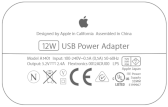When you're working on your robot you'll likely want to plug it into a wall socket rather than run it from batteries. For that you'll need a reliable USB Power Supply with enough current capacity to run your processor (e.g., Raspberry Pi), your sensors, motors and any other accessories (such as displays).
We'll focus on the Raspberry Pi since it generally requires more power than other microcomputers/microcontrollers.
How Much Power?#
 |
Dishonest Advertising?#
The problem is, the companies selling these units are not always very honest about the power ratings of their products. Apple seems to be the worst: they sell two adapters (listed as the Apple 87W USB-C Power Adapter and the 96W USB-C Power Adapter) that are likely the most expensive on the market and are not showing their output ratings in watts but seemingly their power requirements, i.e, not what they deliver but what they use. Of course it says nothing about this on the box. It's 87 watts, right?
 |
Apple is really relying on the ignorance of its customers here.
I made the mistake of buying the 87 watt unit for NZ$120 (wow!), opening the box and finding in fine grey print on the adapter a confusing bunch of different amperage ratings at voltages, but at 5 volts the unit delivers 5 volts at 3 amps (i.e., 3000 mA or milliamps). It says this nowhere on the box; I had to unpack the unit and read the 0.8mm light grey text, then return it to the store.
 |
 or Amps to Watts Calculator
or Amps to Watts Calculator .
.
What's strange is that Apple has delivered honest reporting on its other units. Their tiny 5 watt unit delivers 5 volts at 1 amp. Their 12 watt unit delivers 5.2 volts at 2.4 amps. They provide technical specification for these smaller models, but the "Tech Specs" for the 96 watt model just says "USB C". What gives?
This is where having a bit of your own knowledge is good. These are the two pertinent formulas:
amps = watts ÷ volts watts = amps × voltsIf the Raspberry Pi people say your Pi needs 3 amps, that's not how much power the adapter is using (including power wasted through conversion, heat, etc.), it's how much it's required to deliver.
Some of the units I've found say they supply 3 amps but over two separate USB connections, or say they deliver 3.1 amps but have two USB sockets, so is that 3.1 amps for the whole unit or only 1.55 amps per socket? It's hard to tell when vendors aren't honest. I've got a 3SixT USB charger that has this on the bottom:
that has this on the bottom:
Input: AC 100-240V~, 50/60Hz 0.8A Max
USB 1 Output: 5V = 2.4A Max
USB 2 Output: 5V = 2.4A Max
Of course, on the box it said it was a "4.8A" unit, but it only delivers 2.4 amps per USB socket, which won't do if I need 3 amps (I use it for the 8" monitor for my Pi). At least it on their packaging and their website this was clear. I've another USB charger that has two sockets and says it delivers 3.1A, but doesn't say if that's for the whole unit or per socket. As it's slightly smaller than the 3SixT adapter I'm guessing the whole unit.
It's a tricky business, and rather difficult to figure out. If your power supply is running hot or your Raspberry Pi resets sometimes due to a brownout (the voltage may dip below 5 volts if the adapter can't supply the necessary amperage), your power supply is probably not big enough.